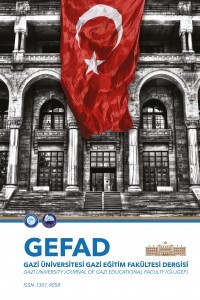Cinsiyetin Farklı Ölçme Teknikleri Kullanılarak Ölçülen Hareket ve Hareket Yasaları Konularındaki Kavramsal Bilgi Düzeyine Etkisi
Ölçme Teknikleri, Cinsiyet, Kavramsal Bilgi Düzeyi, Hareket, Hareket Yasaları
The Effects of Gender on Conceptual Knowledge Level Assessed by Using Different Assessment Techniques on Motion and Motion Laws
Assessment Techniques, Gender, Conceptual Understanding, Motion, Motion Laws,
___
- Bahar, M. &, Hansell, M. H. (2000). The Relationship between some psychological factors and their effect on the performance of grid questions and word association tests. Educational Psychology, c. 20 n. 3, s. 346 – 364.
- Bennett, R. E., Rock, D. A., Braun, H. I., Frye, D., and Sophrer, E. (1990). The relationship of expert-system scored constrained free-response items to multiplechoice and open ended items. Applied Psychological Measurement, c. 14, s. 151-162.
- Bolger, N. and Kellaghan, T. (1990). Method of Measurement and gender differences in Scholastic Achievement. Journal of Educational Measurement, c. 27, s. 165- 174.
- Bransky, J., & Qualter, A. (1993). Applying Physics Concepts-Uncovering the Gender Differences in Assessment of Performance Unit Result. Research in Science and Technological Education, c. 11, n. 2, s. 141-156.
- Breland, H., Danos, D., Kahn, H., Kubota, M., & Sudlow, M. (1991). A study of gender and performance on advenced placement history examinations (College Board Rep. No. 91-4; ETS RR No. 91-61). New York: College Entrance Examination Board.
- Browne, N. and Ross, C. (1991). Girls’ stuff, Boys’ stuff: Young children talking and playing. In N. Browne (Ed.), Science and technology in the early years. Buckingham: Open University Press.
- Burkam, D. T., & Burkam, A. S. (1995). Is Item Format Important? In D. R. Baker, & K. Scantlebury (Eds.), Science “coeducation”: Viewpoints from gender, Race and Ethnic Perpectives. NARTS monograph No. 7, 140-151.
- Burton, N. W. (1996). How have changes in the SAT’s affected women’s math scores. Educational Researcher, c. 15, n. 4, s. 5-9.
- Cataloğlu, E. (1996). Promoting teachers’ awareness of students’ misconceptions in introductory mechanics. Unpublished Master Thesis, METU, Ankara, Turkey.
- DeMars, C. E. (1998). Gender differences in mathematics and science on a high school proficiency exam: the role of responce format,” Applied Measurement in Education, c. 11, n. 3, s. 279-299.
- Dimitrov, M. D. (1999). Gender differences in science achievement: Differential effect of ability, response format, and strands of learning outcomes. Gender Differences in Science Achievement, c. 99, n. 8, s. 445-450.
- Egan, K. (1972). Structrul communication – a new contribution to pedagogy. Programmed Learning and Educational Technology, c. 1, s. 63 – 78.
- Harding, J. (1979). Sex differences in examination performance at 16. Physics Education, c. 14, s. 280-84.
- Hestenes, D, Wells, M., & Swachhamer, G. (1992). Force Concept Inventory. Physics Teacher, 30, 141-153.
- Johnson, S. (1987). Gender differences in science: parallels in interest, experience and performance. International Journal of Science Education, c. 9, n. 4, s. 467-481.
- Johnstone, A. H. (1981). Diagnostic Testing in Science. In Evaluation Roles in Education, Eds. Lewy, A. And Nevo, D. London: Gordon and Breach.
- Johnstone, A. H., Morrison, T. L., and Reid, N. (1981). Chemistry About us. London: Heinemann Educational Books.
- Jovanic, J., Solano-Flores, G. and Shavelson, R. J. (1994). Performans-based assessments: Will gender differences in science achievement be eliminated? Education and Urban Society, c. 26, s. 352-366.
- Kahle, J.B & Meece, J. (1994). Research on gender issue in the classroom. In D. L. Gabel (eds). Handbook of Research on Science Teaching and Learning (p. 542- 558). New York, NY, USA: Macmillan.
- Karaçam, Sedat (2005). Farklı bilişsel stillerdeki lise öğrencilerinin hareket ve hareket yasaları konularındaki kavramları anlama düzeyleri ile ölçme teknikleri arasındaki ilişki. (AİBÜ, Sosyal Bilimler Enstitüsü, Mayıs, 2005).
- Kelly, A. (1988). Sex Stereotypes and School Science, A Three-Year Follow-up,” Educational Studies, c. 14, s. 151-163.
- Mazzoe, J., Schmitt, A., & Bleistein, C. (1992). Sex-related differences on constructedresponces and multiple-choice sections of advenced pacement examinations: Three exploratory studies. Princeton, NJ: Educational Testing Service
- Meece, J. L. & Holt, K. (1993). A Pattern Analysis of Students’ Achievement Goals.
- Journal of Educational Psychology, c. 85, n. 4, s. 582-590.
- Morrell, P. D., & Lederman, N. G. (1998). Students’ Attitudes Towards Shool and Classroom Science: Are They Independent Phenomena? School Science and Mathematics, c. 98, s. 76-82.
- O’Neil, H. F. Jr., & Brown, R. S. 1998. Differential effects of question formats in math assessment on metacognition and affect. Applied in Education, c. 11, n. 4, s. 331- 351.
- Otto, P. B. (1991). One Science, One Sex? School Science And Mathematics, c. 91, n. 8, s. 367-372.
- Scottish Exam Board (1997). Hidher Grade Biology Examination Papers. Glasgow: Gibson.
- Sencar, S., & Eryılmaz, A. (2004). Factors Mediating the Effect of Gender on NinthGrade Turkish Students’ Misconceptions Concerning Electric Circuit. Journal of Research in Science Teaching, c. 41, n. 6, s. 603-616.
- Stobart, G., Elwood, J., and Quilan, M. (1992). Gender Bias in Examinations: How Equal are the Opportunities? British Educational Research Journal, c. 18, n. 3, s. 261-276.
- Yıp, D. Y., Chıu, M. M. and Chu Ho, E. S. (2004). Hong Kong student achievement in OECD-PISA study:Gender differences in science content, literacy, skills, and ıtem formats. Ijma:humnfam, c. 1, n. 2, s. 1-15.
- Whitehouse, H. and Sullivan, M. (1992). Girls and year 12 science examinations.
- Adelaide: Science Secondary Assessment Board of South Australia, Adelaide, Australia.
- Zhang, L. & Manon, J. (2000). Gender and achievement—Understanding gender differences and similarities in mathematics assessment. Paper presented at the annual meeting of the American Educational Research Association (New Orleans, LA, April 24-28, 2000.
- ISSN: 1301-9058
- Yayın Aralığı: Yılda 3 Sayı
- Başlangıç: 1985
- Yayıncı: Gazi Üniversitesi
Beden Eğitimi Öğretmenlerinin Sosyo Ekonomik Beklentileri İle İş Tatmini Arasındaki İlişki
Köye Öğretmen Yetiştirme Yönüyle Köy Enstitüleri
Piyano Dersi Tutum Ölçeğinin Geliştirilmesi
Eğitimcilerin Araştırmaya Dayalı Öğrenme Yaklaşımıyla İlgili Algıları
Üniversite Öğrencilerinin Bazı Kişilik Özelliklerine Göre Sınav Kaygısının İncelenmesi
